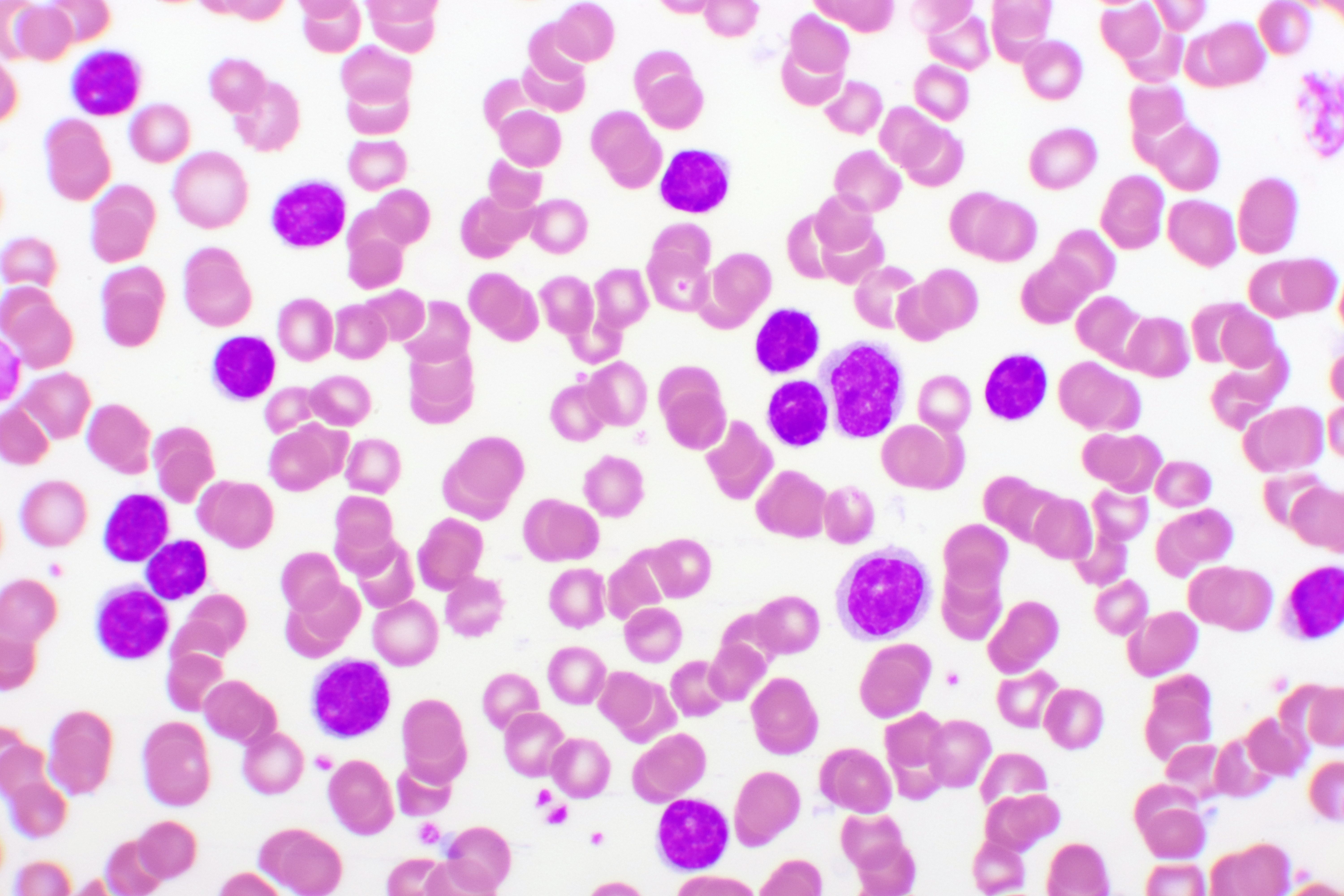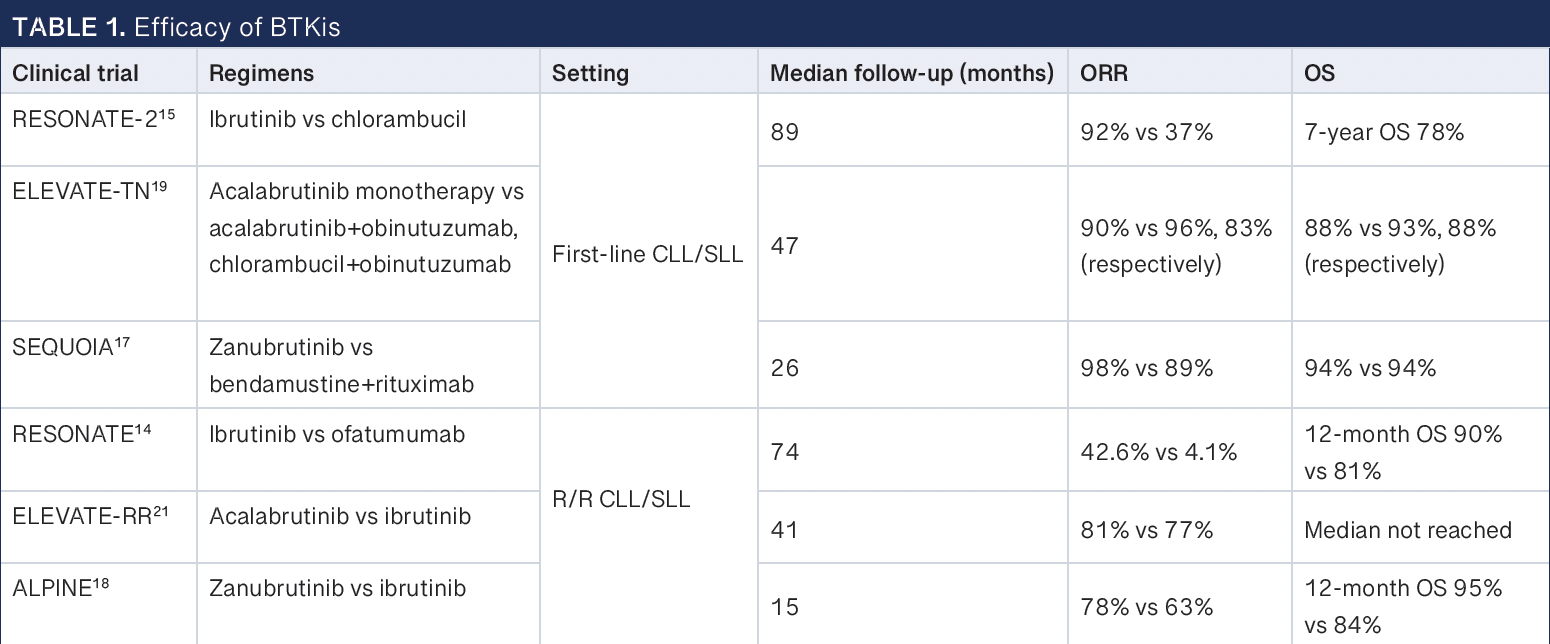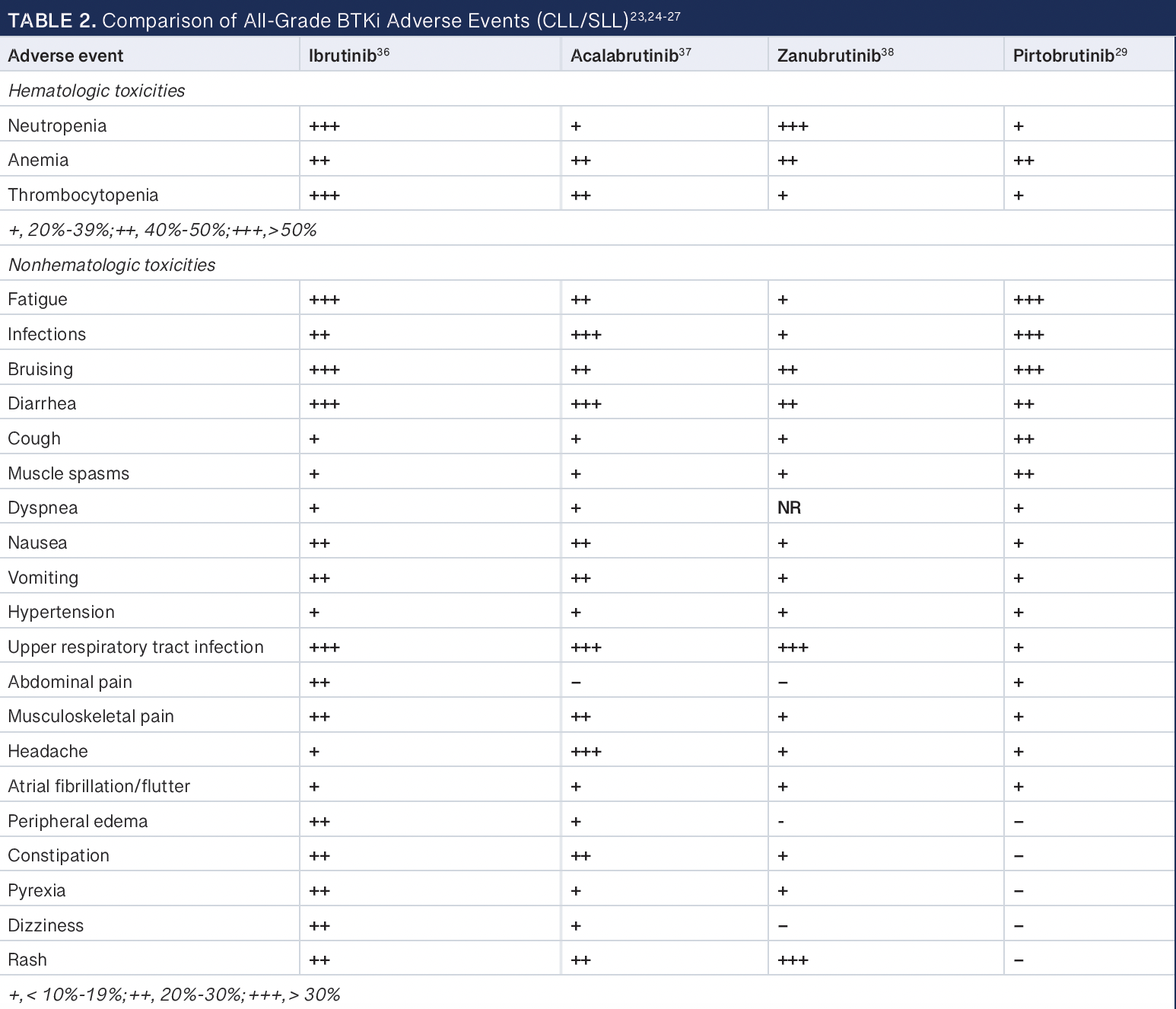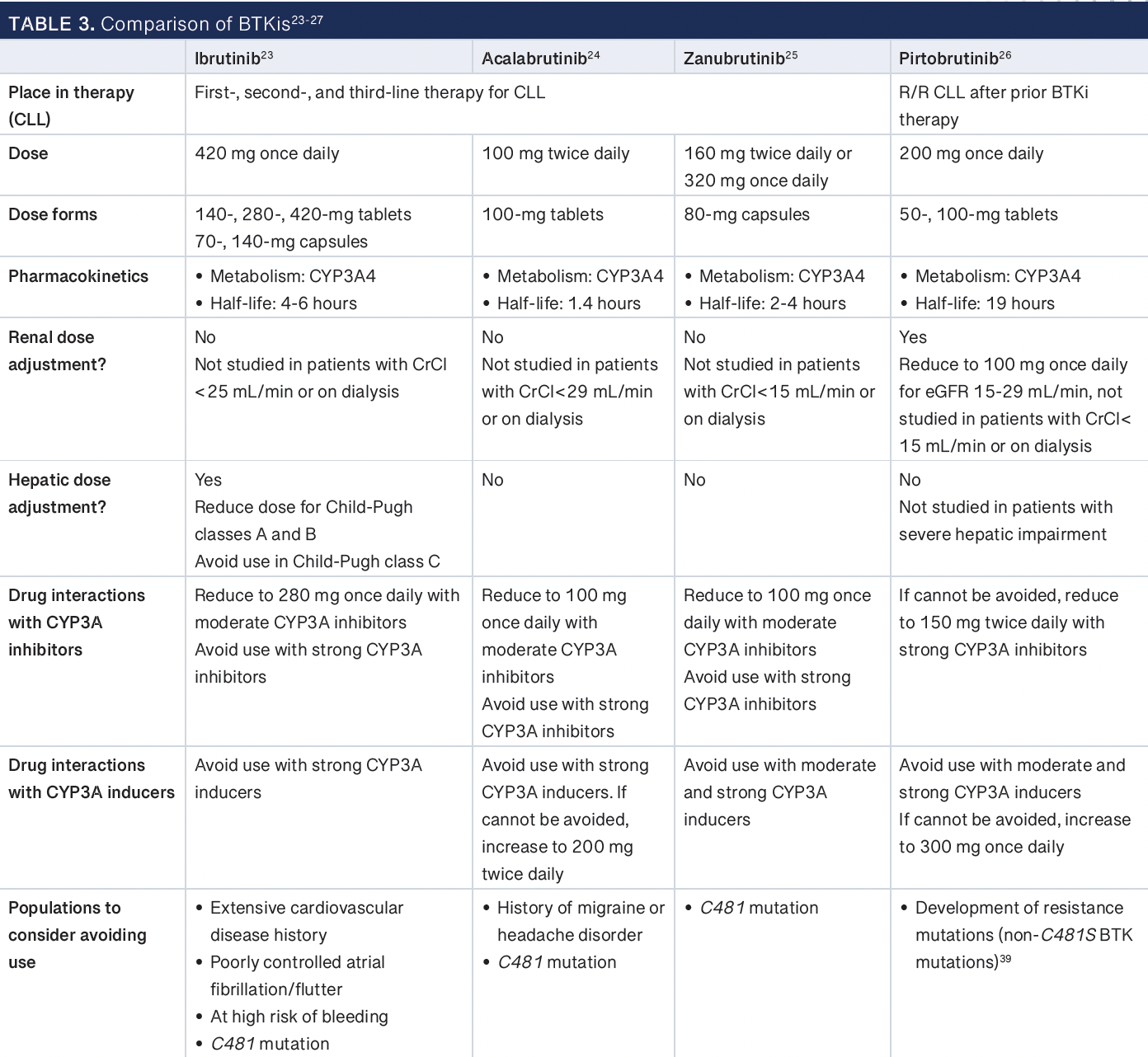Précis
This review discusses the prevalence, mechanisms of development, and evolving treatment landscape in chronic lymphocytic leukemia, highlighting the emergence of Bruton tyrosine kinase inhibitors in 2013 as improved treatment options over traditional chemoimmunotherapy.
Introduction
Chronic lymphocytic leukemia (CLL) is a hematologic malignancy originating in B cells and is the most common type of leukemia in the United States, with 20,700 new diagnoses and 4440 deaths estimated in 2024.1 CLL develops through various mechanisms, all ultimately leading to the clonal expansion of mature B lymphocytes that typically express CD5, CD23, and CD19. Most patients with CLL have an indolent disease course—up to 70% are asymptomatic with incidental lymphocytosis at diagnosis. In these cases, observation is recommended until the patients meet indications for treatment. Symptomatic patients may present with B symptoms (fever, night sweats, unintentional weight loss), cytopenia, and enlarged lymph nodes. Treatment also is required for patients with CLL-related complications such as significant/refractory cytopenia, progressive/symptomatic bulky disease, or end organ dysfunction.
The treatment landscape for CLL has evolved since the introduction of Bruton tyrosine kinase inhibitors (BTKis) in 2013.2 Historical practice utilized traditional chemoimmunotherapy (CIT) such as the FCR regimen (fludarabine, cyclophosphamide, rituximab [Rituxan; Genentech]) for the treatment backbone. Results from the phase 3 CLL-8 trial (NCT00281918) demonstrated long-term progression-free survival (PFS) and overall survival (OS) in fit patients with untreated CLL, but these benefits did not translate well to patients with 17p deletion (del[17p]) or unmutated IGHV.3 Moreover, FCR was associated with prolonged myelosuppression and elevated risk of secondary malignancies.4 These adverse effects (AEs) led to the use of bendamustine (Bendeka; Teva) and rituximab (BR) in patients older than 65 years, based on results of the phase 3 CLL10 trial (NCT00769522), which demonstrated noninferior efficacy and improved safety with BR.4 Despite these developments, overall prognosis among high-risk patients remained poor.5 Genomic testing and further study of mutations allowed for the advent of targeted therapy with BTKis, BCL2 inhibitors, obinutuzumab, and PI3K inhibitors.
Del(17p) results in mutation of the tumor suppressor TP53 gene and is associated with worse response rates, PFS, and OS.6 Accordingly, current guidelines stratify treatment based on presence of this genetic aberration. First-line therapy for patients with or without del(17p)/TP53 consists of acalabrutinib (Calquence; AstraZeneca) with or without obinutuzumab (Gazyva; Genentech), venetoclax (Venclexta; AbbVie and Genentech) plus obinutuzumab, zanubrutinib (Brukinsa, BeiGene USA), or ibrutinib (Imbruvica; Pharmacyclics). Though CIT is additionally recommended in patients without del(17p) or TP53, it is not preferred for use in these patients because several clinical trials demonstrated inferior response rates.7-10 In patients with del(17p), BTKi therapy may be seen in clinical practice more often than venetoclax, given the fixed duration of venetoclax-based therapy compared with indefinite BTKi duration. In the second- or third-line setting, acalabrutinib, zanubrutinib, and venetoclax with or without rituximab are preferred regimens. More recently, pirtobrutinib (Jaypirca; Eli Lilly and Company) received FDA indication for use in patients with relapsed/refractory (R/R) CLL who have previously received a BCL2 inhibitor and a covalent BTKi.11 Overall, BTKis have been established as a mainstay in treatment for patients with CLL and are generally given as continuous therapy until disease progression and/or intolerance.
BTK Inhibitors
BTK, a key step in the B cell receptor (BCR) signaling cascade, is overexpressed in several B-cell malignancies, including CLL. First- and second-generation BTKis bind covalently and irreversibly to Bruton kinase, which disrupts upstream signaling pathways that drive cell proliferation and stimulation of the tumor microenvironment.12 The first BTKi, ibrutinib, was initially approved for patients with CLL in 2014 based on the phase 1/2 PCYC-1192- CA trial (NCT02195869), with further support from the phase 3 RESONATE (NCT01578707) and RESONATE-2 (NCT01722487) trials. These latter studies established improved OS with ibrutinib in both previously treated and treatment-naive patients, with long-term data demonstrating sustained benefit across predefined subgroup analyses (advanced stage, bulky disease, high-risk genetic features, etc).13-16 Despite the promising efficacy results, ibrutinib’s clinically significant AE profile led to the development of second-generation BTKis acalabrutinib and zanubrutinib. In the frontline setting, zanubrutinib exhibited higher event-free survival and overall response rate (ORR) when compared with BR in the phase 3 SEQUOIA trial (NCT03336333).17 For patients with R/R disease, zanubrutinib also showed superior ORR and 2-year PFS compared with ibrutinib.18 Likewise, acalabrutinib monotherapy demonstrated improved PFS compared with obinutuzumab-chlorambucil in the ELEVATE-TN trial (NCT02475681) of treatment-naive patients, as well as noninferior PFS compared with ibrutinib in the ELEVATE-RR trial (NCT02477696) for patients receiving subsequent-line therapy.19-21 Efficacy results are summarized in Table 1.
Though ibrutinib, acalabrutinib, and zanubrutinib sharesimilar toxicities, the second-generation BTKis have lower frequencies of AEs, given their reduced off-target kinase phosphorylation. A classwide effect is lymphocytosis, a treatment-related transient rise in absolute lymphocyte count within hours to weeks after initiation caused by efflux of malignant cells from lymph nodes.22 Other common toxicities include diarrhea, bleeding, fatigue, nausea, rash, headache, dizziness, and cytopenia. Incidences of grade 3 or greater infections across all agents range from 13% to 18%. Grade 3 or greater bleeding occurred in 2% and 3% of patients receiving acalabrutinib and zanubrutinib, respectively, an improvement from the 7% incidence rate seen with ibrutinib in the 8-year follow-up of RESONATE-2.8,16,17 The phase 3 ALPINE trial (NCT03734016) revealed a lower cumulative incidence of atrial fibrillation/flutter (5.2% vs 13.3%) with zanubrutinib compared with ibrutinib, but there were similar rates of any-grade hypertension (21.9% vs 19.8%) and a higher incidence of neutropenia (22.8% vs 18.2%).18 In the ELEVATE-RR trial, there were fewer incidences of atrial fibrillation/flutter (9.4% vs 16%) and hypertension (9.4% vs 23.2%) in the acalabrutinib arm compared with the ibrutinib arm.8,21 Ibrutinib is also associated with significantly higher rates of bleeding, diarrhea, arthralgia, muscle spasms, back pain, contusion, and grade 3 or greater hypertension, whereas patients on acalabrutinib experienced more headache, cough, and grade 3 or greater fatigue. Additional toxicities are summarized in Table 2.23-27
Overall, these data confirm that ibrutinib’s increased off-target kinase activity translates to a higher frequency of AEs. Although all BTKis bind off-target kinase HER4, it is theorized that ibrutinib’s additional binding of HER2 contributes to cardiac toxicity because both kinases are expressed in the heart.28 Ibrutinib’s other off-target pathways—PI3K, CSK, and TEC—are also hypothesized to cause cardiac AEs such as atrial fibrillation. Acalabrutinib and zanubrutinib bind to these off-target kinases to a lesser extent, and thus they have fewer unintended effects given higher selectivity for BTK.29
Lastly, acquired resistance to BTKis is important to consider because of worse clinical outcomes such as decreased OS and PFS in this patient population.30 Acquired ibrutinib resistance can occur in up to 38% of patients and most commonly develops through a C481S residue mutation, which prevents irreversible inhibition of BTK. This leads to inadequate, reversible BTK inhibition, which is due to the short half-life of ibrutinib and thus the insufficient suppression of the BCR signaling pathway.31,32 Because all 3 covalent BTKis target the C481 binding site, a C481S mutation in a patient taking ibrutinib would thus have conferred resistance to acalabrutinib and zanubrutinib as well. This limits clinical utility of these first- or second-generation BTKis after disease progression.33
Pirtobrutinib
Pirtobrutinib is a next-generation BTKi approved by the FDA for patients with R/R mantle cell lymphoma (MCL) and, most recently, approved for patients with R/R CLL. Mechanistically, pirtobrutinib has a few key differences from previously approved BTKis. It is a reversible, noncovalent inhibitor with a unique binding site. Although all BTKis exert their action in the adenosine triphosphate pocket, pirtobrutinib is a back-pocket inhibitor that binds to an area away from C481, which allows it to overcome resistance conferred by the C481S mutation.34 Pirtobrutinib additionally has a longer half-life of 20 hours compared with that of other BTKis (4-6 hours), which theoretically leads to more continuous inhibition of BTK compared with first-generation inhibitors.34 Thus, despite being a reversible inhibitor, the favorable pharmacokinetic profile of pirtobrutinib allows for higher peak concentrations and better plasma drug retention.
Pirtobrutinib information is summarized in Table 2 and Table 3.23-27 The dose of pirtobrutinib is 200 mg by mouth once daily, continued until disease progression or unacceptable toxicity. Pirtobrutinib is metabolized by CYP3A4 and shares similar drug interactions with prior BTKis. AEs are also similar, including cytopenia, infection, bleeding, fatigue, arthralgia, and diarrhea, as well as transient lymphocytosis.23
Initial FDA approval for pirtobrutinib was based on the results of the multicenter phase 1/2 BRUIN study (NCT03740529), which evaluated 773 patients with pretreated B-cell malignancies, including CLL, MCL, Waldenström macroglobulinemia, and follicular lymphoma.35 After a median follow-up of 6 months, ORR was 63% in all patients. In the CLL/small lymphocytic lymphoma (SLL) efficacy cohort, 247 patients received pirtobrutinib after prior treatment with a BTKi, with a median of 3 prior therapies. The ORR was 82.2% when including partial responses in patients with lymphocytosis (73.3% when excluding patients with lymphocytosis). After a median follow-up of 19.4 months, median PFS was 19.6 months. Twelve-month OS was 86%, and 18-month OS was 80.5%. The most common any-grade AEs were infection (71%), neutropenia (32.5%), and bleeding (42.6%), with most grade 3 or higher events being infection or neutropenia. Incidence of atrial fibrillation or flutter was 3.8%. Fewer than 3% of patients discontinued pirtobrutinib because of treatment-related AEs, suggesting overall promising tolerability.34
Pirtobrutinib has demonstrated strong evidence for R/R lymphoid malignancies, which led to FDA approval in R/R CLL. National Comprehensive Cancer Network guidelines for CLL/SLL currently recommend pirtobrutinib use after intolerance or progression with previous BTKis because use in the first-line setting is yet to be established.36
Conclusions and Future Directions
BTKis are a mainstay in CLL treatment, with patient-specific considerations ultimately driving physicians’ choice of agent. Selection depends on AEs, comorbidities, ease of administration, prior lines of systemic therapy, drug-drug interactions, cost, and resistance profile. In patients with a history of cardiovascular disease and atrial fibrillation/flutter, ibrutinib should be avoided if possible. The ELEVATE-RR trial notably excluded patients on concomitant anticoagulation, whereas the SEQUOIA trial did not. Zanubrutinib had a lower risk of hemorrhage in this patient population when compared with ibrutinib, so it may be preferred over acalabrutinib. Given acalabrutinib’s unique toxicity of headaches, caution is advised in patients with a history of severe migraine or headache disorders. Zanubrutinib causes more neutropenia compared with other BTKis, though it has not been directly compared with pirtobrutinib; this is an important consideration in patients with a history of febrile neutropenia.
About the Authors
Arsheeta Kumar, PharmD, is a PGY-2 oncology pharmacy resident at the Fred Hutchinson Cancer Research Center and University of Washington Medicine in Seattle, Washington.
Grace Baek, PharmD, BCOP, is a clinical hematology/ oncology pharmacist at the Fred Hutchinson Cancer Research Center and University of Washington Medicine in Seattle, Washington.
Chloe Siu, PharmD, BCPS, BCOP, is a clinical hematology/oncology pharmacist at the Fred Hutchinson Cancer Research Center and University of Washington Medicine in Seattle, Washington.
All 4 BTKis interact with CYP3A4 inhibitors and inducers, with varying guidance on dose modifications needed (Table 2).23,24-27 Cost is a concern with all 4 BTKis as well, which are only available as brand-name medications. An incremental cost-effectiveness analysis of ibrutinib for Medicare Part D patients with CLL found estimated out-of-pocket costs of $20,847 for a 30-month course in the relapsed setting.37 This cost consideration can place a significant burden on patients and may negatively impact treatment adherence.
Direct comparison of pirtobrutinib with other treatment options in a population with R/R CLL/ SLL is limited by a lack of prospective data. Because most patients will need to be treated with a BTKi for a considerable length of time, long-term efficacy and safety data for pirtobrutinib are similarly limited at this time. Ongoing phase 3 studies may help bridge these gaps and solidify the role of pirtobrutinib in the CLL treatment paradigm. BRUIN-CLL-314 (NCT05254743) is an ongoing phase 3 trial comparing pirtobrutinib with ibrutinib in patients with treatment-naive or R/R CLL, which may help further elucidate safety differences between the 2 agents.38 Although pirtobrutinib efficacy after intolerance to acalabrutinib and zanubrutinib in CLL has been demonstrated in BRUIN, there remains a lack of head-to-head trials directly comparing the efficacy of these 3 BTKis. Additional noncovalent, reversible BTKis such as nemtabrutinib are being evaluated in phase 1 studies.28 BTK degrader molecules such as first-in-class agent NX-2127 are also under investigation, and they may provide an option for heavily pretreated patients with R/R disease, including those who previously received pirtobrutinib.38-40 These agents, along with pirtobrutinib, will continue to change the CLL treatment landscape in terms of both safety and efficacy.
References
1. Key statistics for chronic lymphocytic leukemia. American Cancer Society. Updated January 17, 2024. Accessed March 14, 2024. https://www.cancer.org/cancer/types/chronic-lymphocytic-leukemia/about/key-statistics.html
2. Rozkiewicz D, Hermanowicz JM, Kwiatkowska I, Krupa A, Pawlak D. Bruton's Tyrosine Kinase Inhibitors (BTKIs): Review of Preclinical Studies and Evaluation of Clinical Trials. Molecules. 2023;28(5):2400. doi:10.3390/molecules28052400
3. Fischer K, Bahlo J, Fink AM, et al. Long-term remissions after FCR chemoimmunotherapy in previously untreated patients with CLL: updated results of the CLL8 trial. Blood. 2016;127(2):208-215. doi:10.1182/blood-2015-06-651125
4. Eichhorst B, Fink AM, Bahlo J, et al; German CLL Study Group (GCLLSG). First-line chemoimmunotherapy with bendamustine and rituximab versus fludarabine, cyclophosphamide, and rituximab in patients with advanced chronic lymphocytic leukaemia (CLL10): an international, open-label, randomised, phase 3, non-inferiority trial. Lancet Oncol. 2016;17(7):928-942. doi:10.1016/S1470-2045(16)30051-1
5. Skarbnik AP, Faderl S. The role of combined fludarabine, cyclophosphamide and rituximab chemoimmunotherapy in chronic lymphocytic leukemia: current evidence and controversies. Ther Adv Hematol. 2017;8(3):99-105. doi:10.1177/2040620716681749
6. Bomben R, Rossi FM, Vit F, et al. Clinical impact of TP53 disruption in chronic lymphocytic leukemia patients treated with ibrutinib: a campus CLL study. Leukemia. 2023;37(4):914-918. doi:10.1038/s41375-023-01845-9
7. Fischer K, Al-Sawaf O, Bahlo J, et al. Venetoclax and obinutuzumab in patients with CLL and coexisting conditions. N Engl J Med. 2019;380(23):2225-2236. doi:10.1056/NEJMoa1815281
8. Byrd JC, Hillmen P, Ghia P, et al. Acalabrutinib versus ibrutinib in previously treated chronic lymphocytic leukemia: results of the first randomized phase III trial. J Clin Oncol. 2021;39(31):3441-3452. doi:10.1200/JCO.21.01210
9. Shanafelt TD, Wang XV, Kay NE, et al. Ibrutinib-rituximab or chemoimmunotherapy for chronic lymphocytic leukemia. N Engl J Med. 2019;381(5):432-443. doi:10.1056/NEJMoa1817073
10. Woyach JA, Ruppert AS, Heerema NA, et al. Ibrutinib regimens versus chemoimmunotherapy in older patients with untreated CLL. N Engl J Med. 2018;379(26):2517-2528. doi:10.1056/NEJMoa1812836
11. NCCN. Clinical Practical Guidelines in Oncology. Chronic lymphocytic leukemia/small lymphocytic lymphoma; version 2.2024. Accessed September 13, 2023. https://www.nccn.org/professionals/physician_gls/pdf/cll.pdf
12. Pal Singh S, Dammeijer F, Hendriks RW. Role of Bruton’s tyrosine kinase in B cells and malignancies. Mol Cancer. 2018;17(1):57. doi:10.1186/s12943-018-0779-z
13. Burger JA, Tedeschi A, Barr PM, et al; RESONATE-2 Investigators. Ibrutinib as initial therapy for patients with chronic lymphocytic leukemia. N Engl J Med. 2015;373(25):2425-2437. doi:10.1056/NEJMoa1509388
14. Byrd JC, Brown JR, O’Brien S, et al; RESONATE Investigators. Ibrutinib versus ofatumumab in previously treated chronic lymphoid leukemia. N Engl J Med. 2014;371(3):213-223. doi:10.1056/NEJMoa1400376
15. Munir T, Brown JR, O’Brien S, et al. Final analysis from RESONATE: up to six years of follow-up on ibrutinib in patients with previously treated chronic lymphocytic leukemia or small lymphocytic lymphoma. Am J Hematol. 2019;94(12):1353-1363. doi:10.1002/ajh.25638
16. Barr PM, Owen C, Robak T, et al. Up to 8-year follow-up from RESONATE-2: first-line ibrutinib treatment for patients with chronic lymphocytic leukemia. Blood Adv. 2022;6(11):3440-3450. doi:10.1182/bloodadvances.2021006434
17. Tam CS, Brown JR, Kahl BS, et al. Zanubrutinib versus bendamustine and rituximab in untreated chronic lymphocytic leukaemia and small lymphocytic lymphoma (SEQUOIA): a randomised, controlled, phase 3 trial. Lancet Oncol. 2022;23(8):1031-1043. doi:10.1016/S1470-2045(22)00293-5
18. Brown JR, Eichhorst B, Hillmen P, et al. Zanubrutinib or ibrutinib in relapsed or refractory chronic lymphocytic leukemia. N Engl J Med. 2023;388(4):319-332. doi:10.1056/NEJMoa2211582
19. Sharman JP, Egyed M, Jurczak W, et al. Acalabrutinib with or without obinutuzumab versus chlorambucil and obinutuzumab for treatment-naive chronic lymphocytic leukaemia (ELEVATE-TN): a randomised, controlled, phase 3 trial.Lancet. 2020;395(10232):1278-1291. doi:10.1016/S0140-6736(20)30262-2
20. Sharman JP, Egyed M, Jurczak W, et al. Efficacy and safety in a 4-year follow-up of the ELEVATE-TN study comparing acalabrutinib with or without obinutuzumab versus obinutuzumab plus chlorambucil in treatment-naive chronic lymphocytic leukemia. Leukemia. 2022;36(4):1171-1175. doi:10.1038/s41375-021-01485-x
21. Seymour JF, Byrd JC, Ghia P, et al. Detailed safety profile of acalabrutinib vs ibrutinib in previously treated chronic lymphocytic leukemia in the ELEVATE-RR trial. Blood. 2023;142(8):687-699. doi:10.1182/blood.2022018818
22.Herman SEM, Niemann CU, Farooqui M, et al. Ibrutinib-induced lymphocytosis in patients with chronic lymphocytic leukemia: correlative analyses from a phase II study. Leukemia. 2014;28(11):2188-2196. doi:10.1038/leu.2014.122
23. Jaypirca. Prescribing information. Eli Lilly; 2023. Accessed March 14, 2024. https://www.accessdata.fda.gov/drugsatfda_docs/label/2023/216059Orig1s000Corrected_lbl.pdf
24. Mato AR, Wierda WG, Ai WZ, et al. NX-2127-001, a first-in-human trial of NX-2127, a Bruton’s tyrosine kinase-targeted protein degrader, in patients with relapsed or refractory chronic lymphocytic leukemia and B-cell malignancies. Blood. 2022;140(suppl 1):2329-2332. doi:10.1182/blood-2022-164772
25. Imbruvica. Prescribing information. Pharmacyclics; 2015. Accessed March 14, 2024. https://www.accessdata.fda.gov/drugsatfda_docs/label/2015/205552s002lbl.pdf
26. Calquence. Prescribing information. AstraZeneca Pharmaceuticals; 2017. Accessed March 14, 2024. https://www.accessdata.fda.gov/drugsatfda_docs/label/2017/210259s000lbl.pdf
27. Brukinsa. Prescribing information. BeiGene; 2021. Accessed March 14, 2024. https://www.accessdata.fda.gov/drugsatfda_docs/label/2021/213217s005lbl.pdf
28. Dong R, Yan Y, Zeng X, Lin N, Tan B. Ibrutinib-associated cardiotoxicity: from the pharmaceutical to the clinical. Drug Des Devel Ther. 2022;16:3225-3239. doi:10.2147/DDDT.S377697
29. Estupiñán HY, Berglöf A, Zain R, Smith CIE. Comparative analysis of BTK inhibitors and mechanisms underlying adverse effects. Front Cell Dev Biol.2021;9:630942. doi:10.3389/fcell.2021.630942
30. Stephens DM, Byrd JC. Resistance to Bruton tyrosine kinase inhibitors: the Achilles heel of their success story in lymphoid malignancies. Blood. 2021;138(13):1099-1109. doi:10.1182/blood.2020006783
31. Woyach JA, Ruppert AS, Guinn D, et al. BTKC481S-mediated resistance to ibrutinib in chronic lymphocytic leukemia. J Clin Oncol. 2017;35(13):1437-1443. doi:10.1200/JCO.2016.70.2282
32. Thompson PA, Tam CS. Pirtobrutinib: a new hope for patients with BTK inhibitor-refractory lymphoproliferative disorders. Blood. 2023;141(26):3137-3142. doi:10.1182/blood.2023020240
33. Aslan B, Kismali G, Iles LR, et al. Pirtobrutinib inhibits wild-type and mutant Bruton’s tyrosine kinase-mediated signaling in chronic lymphocytic leukemia. Blood Cancer J. 2022;12(5):1-12. doi:10.1038/s41408-022-00675-9
34. Mato AR, Woyach JA, Brown JR, et al. Pirtobrutinib after a covalent BTK inhibitor in chronic lymphocytic leukemia. N Engl J Med. 2023;389(1):33-44. doi:10.1056/NEJMoa2300696
35. Mato AR, Shah NN, Jurczak W, et al. Pirtobrutinib in relapsed or refractory B-cell malignancies (BRUIN): a phase 1/2 study. Lancet. 2021;397(10277):892-901. doi:10.1016/S0140-6736(21)00224-5
36. Shanafelt TD, Borah BJ, Finnes HD, et al. Impact of ibrutinib and idelalisib on the pharmaceutical cost of treating chronic lymphocytic leukemia at the individual and societal levels. J Oncol Pract. 2015;11(3):252-258. doi:10.1200/JOP.2014.002469
37. Woyach JA, Wierda WG, Coombs CC, et al. BRUIN CLL-314: A phase III open-label, randomized study of pirtobrutinib (LOXO-305) versus ibrutinib in patients with chronic lymphocytic leukemia/small lymphocytic lymphoma. Blood. 2022;140(suppl 1):12427-12428. doi:10.1182/blood-2022-157589
38. Reiff SD, Mantel R, Smith LL, et al. The BTK inhibitor ARQ 531 targets ibrutinib-resistant CLL and Richter transformation. Cancer Discov. 2018;8(10):1300-1315. doi:10.1158/2159-8290.CD-17-1409
39. Jebaraj BMC, Müller A, Dheenadayalan RP, et al. Evaluation of vecabrutinib as a model for noncovalent BTK/ITK inhibition for treatment of chronic lymphocytic leukemia. Blood. 2022;139(6):859-875. doi:10.1182/blood.2021011516
40. Wang E, Mi X, Thompson MC, et al. Mechanisms of resistance to noncovalent Bruton’s tyrosine kinase inhibitors. N Engl J Med. 2022;386(8):735-743. doi:10.1056/NEJMoa2114110
Disclosures
The authors have no disclosures.





